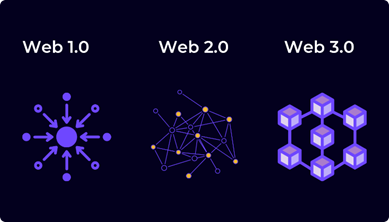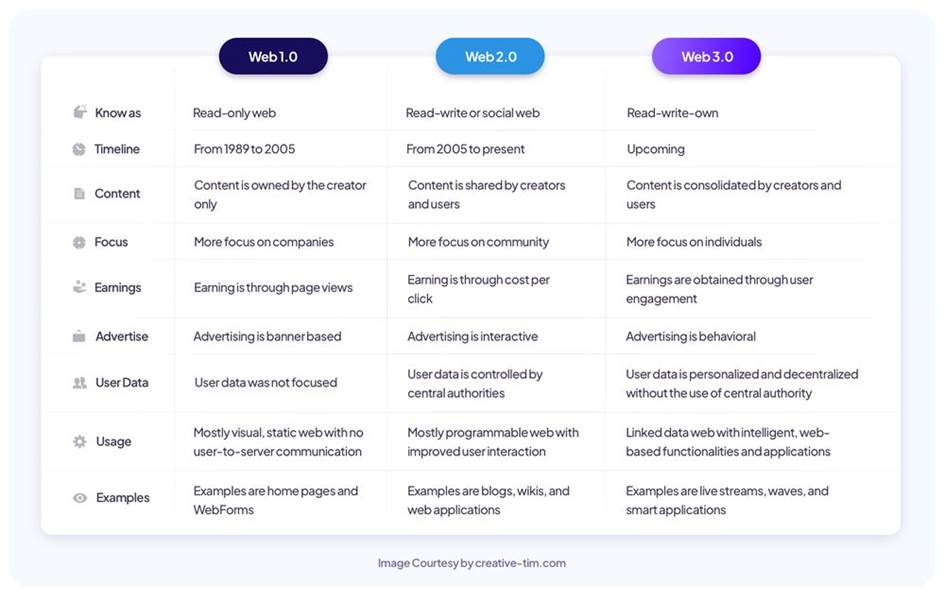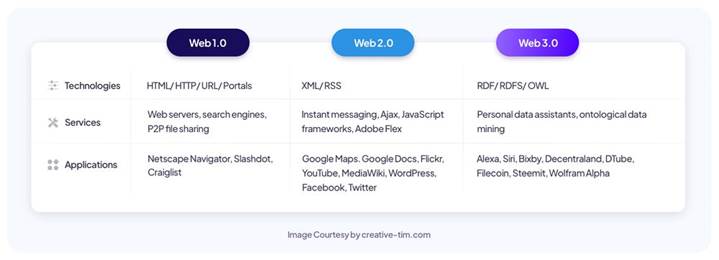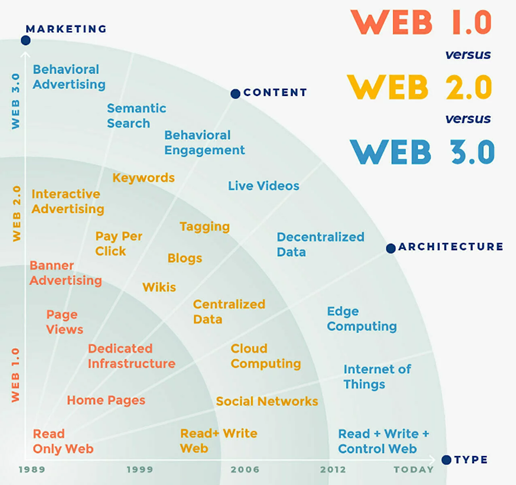Description

Disclaimer: Copyright infringement not intended.
Context
- India has a rapidly-growing Web3 ecosystem with more than 450 active start-ups in the space-Nasscom.
Background
What is World Wide Web?
- World Wide Web, which is also known as a Web, is a collection of websites or web pages stored in web servers and connected to local computers through the internet.
- These websites contain text pages, digital images, audios, videos, etc. Users can access the content of these sites from any part of the world over the internet using their devices such as computers, laptops, cell phones, etc. The WWW, along with internet, enables the retrieval and display of text and media to a device.
- So, the web/www provides a communication platform for users to retrieve and exchange information over the internet.
Web 1.0
- Web 1.0 is the earliest form of the internet created by Tim Berners Lee in 1989 that existed between the years of 1991 to 2005.
- It is an era where content creators were fewer in number and the wide majority instead were consumers of data. Users were allowed to view the content placed on websites but were not able to collaborate, give feedback, or add their own content to these websites. So, people could just access facts, information, and content from the source.
- Web 1.0 made the use of static HTML and displayed content using tables and frames.
- Websites were mostly static and data was stored predominantly in filesystems.
- Web 1.0 can be thought of as a massive digital encyclopedia that lacked interactivity.
A few elements that define Web 1.0 can include:
- Static pages.
- HTML 3.2 elements such as frames and tables.
- HTML forms sent via email.
- Content from the server's filesystem, rather than a relational database management system.
- GIF buttons and graphics.
The primary technologies that comprised web 1.0 were:
- HTML (HyperText Markup Language)
- HTTP (HyperText Transfer Protocol)
- URL (Uniform Resource Locator)
Weaknesses in Web 1.0 led to the evolution of Web 2.0.
Web 2.0
- With Web 2.0, the focus moved away from a small amount of people making a large amount of content, to a large amount of people making even more content.
- Instead of static websites that simply pushed content, Web 2.0 introduced the concept of blogging, and zooming, scrolling, and manipulating content such as in Google Maps.
- This form of the internet emphasised UGC, ease of use, participation and interactivity, and compatibility with other devices and systems.
- Communities, collaborations, dialogue and social media popped up in Web 2.0. Web 2.0 is also the era that saw the rise of Software as a Service (SaaS) solutions and the use of technologies like HTML5, CSS3, and JavaScript frameworks.
A few elements that define Web 1.0 can include:
- Free sorting of information
- Developed APIs
- Self-usage
- Dynamic content
- Wide societal use, not just specific communities
- Ease of information sharing.
- Huge variety of information in a single click.
Basically, to summarise Web 2.0: the user has become the product.
Web 2.0, or the 'social web', involves a number of tools and platforms where people can share their opinions, day-to-day, and perspectives, in a hyper interactive way. So, this can involve:
- Podcasting
- Social media
- Tagging
- Blogging
- Commenting
- Voting
Issue
- The issue with Web 2.0 comes from the way the traditional Web 2.0 application works. A user will make a request to the server, which will then be sent to the webpage as a response. The only thing is whoever controls the data on the centralised server has access to a hell of a lot of data.
- Facebook, Google and Twitter began storing this data in their servers, in order to make better content using algorithms. Our data was then sold to advertisers.
Web 2 weaknesses:
- Risk of virus, fraud, and spam attacks.
- Risk of getting wrong information since the variety, veracity, and volume of information is too large.
- Compromised security since Web 2 users are at the mercy of the Big Tech companies (Alphabet (Google), Amazon, Meta (Facebook), Apple, and Microsoft) which store almost all their data.
- Information censoring by the Big Tech companies who can censor the information users are trying to access.
- Economic benefits are only limited to the Big Tech companies even though the content being introduced in the WWW is generated mainly by users.
- A centralized financial system whereby the financial system is centrally managed by a few central banks and financial institutions that have access to users' data.
The dependence of Web 2.0 on the Big Tech companies is not acceptable to general users, and is thus revolutionizing how people use the web. This is giving rise to a new era of the WWW called the Web 3.0.
Web 3.0
- Web 3.0 is also known as the read-write-execute web and introduces the concept of machine learning, artificial intelligence, and blockchain systems. It is built upon the core concepts of decentralization, openness and and token-based economics.
- The term "Web3" was coined by Polkadot founder and Ethereum co-founder Gavin Wood in 2014, referring to a "decentralized online ecosystem based on blockchain."
Elements
- Decentralized: It is the concept that believes that content and data must be owned and controlled by decentralized autonomous bodies, thus reducing the censorship and centralized control exercised by the Big Tech companies. Payments in Web 3.0 use token-based authentication, thus personal data does not need to be shared with third-party intermediaries. Once smart contracts are deployed, they execute as written without the need for an intermediary.
- Artificial Intelligence and Machine Learning: Web 3.0 is based on Natural Language Processing (NLP) which allows the web to analyze and derive the meaning of spoken and written words. Thus, web tech is improved to create, share, and connect content through search and analysis, based on comprehension not key words.
- Ubiquity: Web 3.0 envisions that systems are available anywhere and everywhere because of the use of decentralized servers, thus reducing the dependency on Big Tech that exists with Web 2.0.
- 3D graphics and spatial web: Web 3.0 is also set to transition from 2D to 3D systems coupled with NLP and machine learning. Web 3.0 will see the merging of reality with virtual worlds using sensors, smart glasses, and AR/VR technologies.
- Open – It’s ‘open’ in the sense that it’s made with open-source software developed by an open and available community of developers and accomplished in full view of the public.
- Trustless – The network offers freedom to users to interact publicly and privately without an intermediary exposing them to risks, hence “trustless” data.
- Permissionless – Anyone, including users and providers, can engage without the need for permission from a controlling organization.
- Artificial Intelligence & Machine Learning - Artificial intelligence and machine learning algorithms have advanced to make valuable, and sometimes life-saving, predictions and acts.
- When built on top of emerging decentralized data structures that provide access to a plethora of data that today’s tech titans desire, the possible applications extend far beyond targeted advertising into areas such as:
- Precision materials
- Medication creation
- Climate modeling
Although Web 2.0 has similar capabilities, it is still primarily human-based, allowing for corrupt behaviors such as biased product evaluations, rigged ratings, human errors, etc.

Web 3.0 strengths
- Since information can be accessed from all ends of the web spectrum, it makes data interoperable across different platforms and IoT devices.
- Use of permissionless blockchains thus reducing limitations that exist due to wealth, geographic location, gender, or other demographics.
- Removal of a central authority leading to self-governance and distributed ownership.
- Improved security because of the distribution, decentralization, and use of blockchain technologies.
- Reduced dependence on the Big Tech companies.
- No need to share personal information with third parties when making payments.



Conclusion
- The idea behind web 3.0 is to make searches on the Internet much faster, easier and more efficient to process even complex search sentences in no time. The end-users will get the most significant advantage of data encryption to protect their information from disclosure. It will prevent large organizations like Google and Apple from controlling or using people’s personal information for their own interest.
- Decentralized data storage will ensure that the data is accessible to users in any circumstance. Additionally, no entity or government organization will have the ability to stop any services or websites. The data will be accessible from anywhere and from any device
- It will help disintermediate businesses, remove rent-seeking intermediaries, and give this value directly to the customers and providers in a network.
|
Examples of Web 3.0 in Real Life
For instance, while you’re sitting in the office, if you wish to check the availability of groceries in your home, you can ask your digital assistant to examine the contents of your fridge by communicating with the interconnected smart devices at your house.
Moreover, you can organize your holiday plan, business trip, weekend party, household tasks and even ensure your home security by using your ubiquitous Internet-connected devices at home. The virtual assistant’s personalized recommendations help you arrange the perfect weekend, from booking your tickets with a discount to finding exciting places to explore to reserving hotels.
Siri is a perfect example of voice recognition software as a key component of web 3.0.
|
https://www.thehindu.com/business/Economy/india-fast-emerging-as-a-sizeable-web3-ecosystem/article66030874.ece














